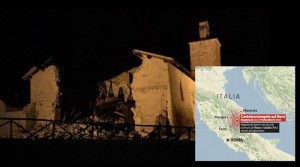An 6.0-magnitude earthquake hit the Marche region in central Italy, just hours after a 5.4-magnitude temblor damaged buildings and cut power lines across the area. Buildings across the region have been damaged, but so far, there have been no reports of fatalities.
The latest earthquake occurred 71 km east of Perugia, with United States Geological Survey reporting it as a 6.0-magnitude temblor, and Italy’s National Institute of Geophysics and Volcanology saying it was 5.9-magnitude. The first earthquake was detected at 7:11pm local time, about 66km to the southeast of Perugia, striking a mountainous part of the Marche region and lasting several seconds.The exact epicenter of the tremor remains unclear, but it was relatively shallow, at about 9km below ground. Within an hour of the first earthquake, there was a series of small but noticeable aftershocks, ranging in magnitude from 2.5 to 2.8.
“We’re in the square, all the lights are out, we can’t see, we’re counting each other to see who’s here, we still don’t know how bad the situation is,” Mauro Falcucci, mayor of Castelsantangelo sul Nera, the small commune closest to the epicenter, told Sky News by phone. “The situation is delicate. It is important to remain calm.”
The official said that the emergency is exacerbated by a downpour, and intermittent problems with mobile phone communication. The Civil Protection agency, the centralized service which is receiving infromation from dozens of tiny settlements scattered across the area, say that older buildings have been damaged, or collapsed entirely, but that no injuries have been reported. Wednesday’s quakes occurred less than 70km to the north of Amatrice, a village in the seismically unstable central Apennines region that was hit by a series of earthquakes in August, resulting in nearly 300 deaths. The strongest impact there was a 6.2 earthquake on August 24, followed by more than a dozen aftershocks over the next several days.
“This earthquake is likely the activation of a new faultline, connected to August’s calamity. But we need to get closer to the epicenter, before drawing conclusions,” said Paul Messina, for the Institute of Environmental Geology and Geoengineering of the Italian National Research Council.
source: RT





